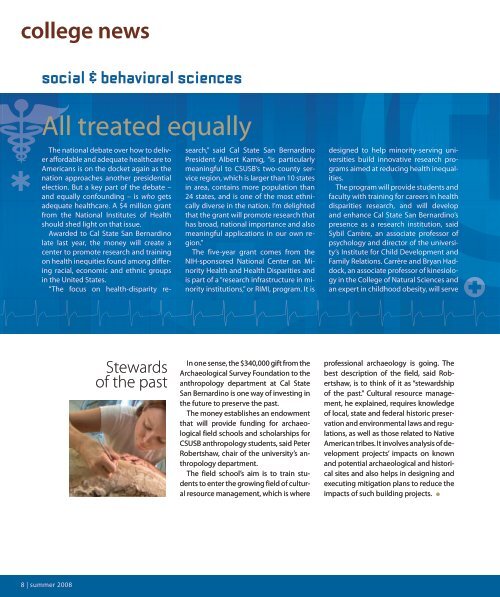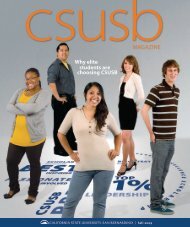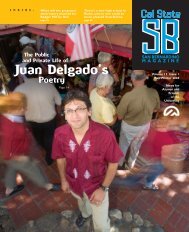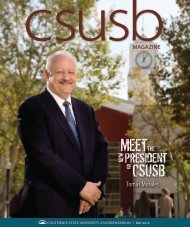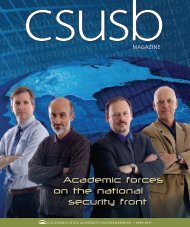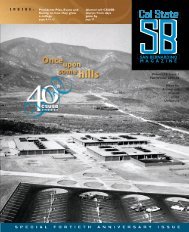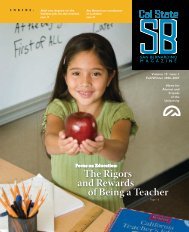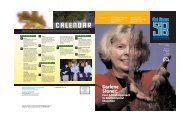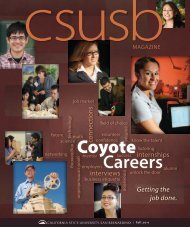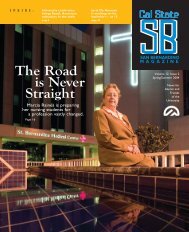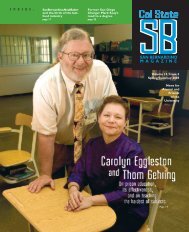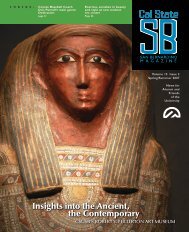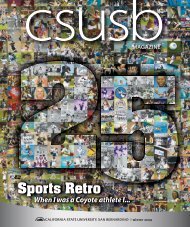Paul Mata and CSUSB alumni think about how many miles one ...
Paul Mata and CSUSB alumni think about how many miles one ...
Paul Mata and CSUSB alumni think about how many miles one ...
- No tags were found...
Create successful ePaper yourself
Turn your PDF publications into a flip-book with our unique Google optimized e-Paper software.
college newssocial & behavioral sciencesAll treated equallyThe national debate over <strong>how</strong> to deliveraffordable <strong>and</strong> adequate healthcare toAmericans is on the docket again as thenation approaches another presidentialelection. But a key part of the debate –<strong>and</strong> equally confounding – is who getsadequate healthcare. A $4 million grantfrom the National Institutes of Healthshould shed light on that issue.Awarded to Cal State San Bernardinolate last year, the m<strong>one</strong>y will create acenter to promote research <strong>and</strong> trainingon health inequities found among differingracial, economic <strong>and</strong> ethnic groupsin the United States.“The focus on health-disparity research,”said Cal State San BernardinoPresident Albert Karnig, “is particularlymeaningful to <strong>CSUSB</strong>’s two-county serviceregion, which is larger than 10 statesin area, contains more population than24 states, <strong>and</strong> is <strong>one</strong> of the most ethnicallydiverse in the nation. I’m delightedthat the grant will promote research thathas broad, national importance <strong>and</strong> alsomeaningful applications in our own region.”The five-year grant comes from theNIH-sponsored National Center on MinorityHealth <strong>and</strong> Health Disparities <strong>and</strong>is part of a “research infrastructure in minorityinstitutions,” or RIMI, program. It isdesigned to help minority-serving universitiesbuild innovative research programsaimed at reducing health inequalities.The program will provide students <strong>and</strong>faculty with training for careers in healthdisparities research, <strong>and</strong> will develop<strong>and</strong> enhance Cal State San Bernardino’spresence as a research institution, saidSybil Carrère, an associate professor ofpsychology <strong>and</strong> director of the university’sInstitute for Child Development <strong>and</strong>Family Relations. Carrère <strong>and</strong> Bryan Haddock,an associate professor of kinesiologyin the College of Natural Sciences <strong>and</strong>an expert in childhood obesity, will serveStewardsof the pastIn <strong>one</strong> sense, the $340,000 gift from theArchaeological Survey Foundation to theanthropology department at Cal StateSan Bernardino is <strong>one</strong> way of investing inthe future to preserve the past.The m<strong>one</strong>y establishes an endowmentthat will provide funding for archaeologicalfield schools <strong>and</strong> scholarships for<strong>CSUSB</strong> anthropology students, said PeterRobertshaw, chair of the university’s anthropologydepartment.The field school’s aim is to train studentsto enter the growing field of culturalresource management, which is whereprofessional archaeology is going. Thebest description of the field, said Robertshaw,is to <strong>think</strong> of it as “stewardshipof the past.” Cultural resource management,he explained, requires knowledgeof local, state <strong>and</strong> federal historic preservation<strong>and</strong> environmental laws <strong>and</strong> regulations,as well as those related to NativeAmerican tribes. It involves analysis of developmentprojects’ impacts on known<strong>and</strong> potential archaeological <strong>and</strong> historicalsites <strong>and</strong> also helps in designing <strong>and</strong>executing mitigation plans to reduce theimpacts of such building projects. ●8 | summer 2008


